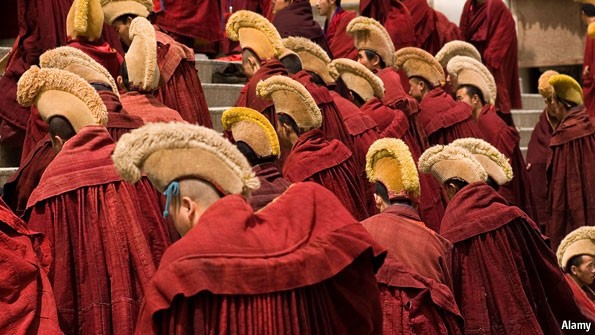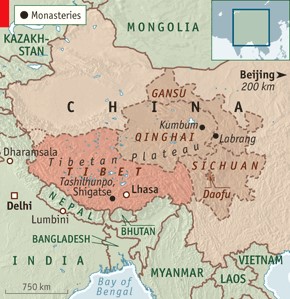 
 字體:小 中 大
字體:小 中 大 |
|
|
|
| 2018/03/03 20:54:11瀏覽18|回應0|推薦0 | |
More turbulent monks May 5th 2011, 02:57
Many People describe or classify Tibetan affairs as historical one or the ethnic problem. Nowadays Beijing has been controlling Tibet for more than 60 years, and must feel worried and anxious about disputes every Mar.14. From the establishment of people’s government of Chinese Communist Party, Mao Ze-Dong announced the definition of territory including Taiwan and Tibet. The most famous incident is General Chang Jin-Wu’s military behaviour to declare the sovereignty in Lhasa in 1959. I have seen many articles wriiten by JAIHA or Devils Advocate_1’s post or like these. If you really once read the Chinese history from Tang Dynasty to the day when 14th Daila Lama’s showed his desire to to resign, anyone can easily find this truth that Tibetan has been loving Yellow River and this dragon’s inhabitant by means of sign the peaceful treaty in strong emperor’s period or rob Chinese capital of local women, silk and gold again and again in decline of this region. Overall, The truth is that Tibet has been wanting to get together with China instead of India in any form at any time. Since Tibet loves China very much, of course, Beijing can control Tibet beyond question, and Chinese Communist Party gives the right of autonomy to Tibetan, don’t they?. Don’t only use strange so-called religious image to cheat on anyone. To enjoy the combination with Beijing peacefully is the best way to make yourself happy.
Recommended 3 Report Permalink 這片原來的雜誌文章找不到。筆者拿在1951年踩砂畫見西藏噶廈的張經武來提真狠,真絕,我真佩服我當年自己。說來吐蕃也很喜歡說自己是中國的一部份,還進犯過大唐的首都,擄走不少長安城良家婦女及少女,跟大唐皇帝說是中國的正統領導過不是嗎?長安西域沐浴著太平,法國總統每每出訪中國必去思古鑑今,如今年一月的馬克宏總統,就是指一個中國的古今體現。有網友回文當然是說中共就是不對,就說所以中國和西藏是兩個國家云云:也有語法上的問題。太過口語化在經濟學人的討論區不雅觀,以後筆者就有注意了。 前幾天北京市長兼市委書記蔡奇擁呼聲指出會出任中共的統戰部長,除了去年達賴喇嘛十四世派代表在雲南省昆明談判,有可能蔡的上任代表達賴可以回國了。 附一篇8月20日刊在當期亞洲版的特別報導: China, Tibet and the Dalai LamaLamas at loggerheads Three articles look at China and religion. First, a war of attrition over Tibet; next, China v the Vatican; third, a Chinese project at the Buddha’s birthplaceAug 20th 2011 | BEIJING | from the print edition
IT WAS never going to be easy. Installing the Chinese Communist Party’s chosen man as Tibet’s second-highest ranking religious leader has been an uphill struggle since 1995, when it declared him, at the ripe old age of six, to be the new Panchen Lama. But a recent attempt to introduce him to monastic life suggests that Tibetan resistance to China’s choice is still strong. Loyalty to the young man is brittle. For China, this matters hugely. Tibetan Buddhism has a religious hierarchy with the Dalai Lama at the top, followed by the Panchen Lama. The Dalai Lama is traditionally involved in recognising the Panchen Lama, and the Panchen Lama is part of the process by which each new Dalai Lama is chosen. China has its eyes on a complex struggle that will play out after the death of the current 76-year-old Dalai Lama, who lives in exile in India. With the endorsement of its own Panchen Lama, China wants to choose a successor to the current Dalai Lama and seek to control him. Hence it is believed to be keeping another young man, who was the Dalai Lama’s choice as Panchen Lama 16 years ago, incommunicado in an unknown location. China fears that Tibetan exiles will appoint their own Dalai Lama and it does not want any authoritative Tibetan figure to show him support. Both China and the exiles have recently been stepping up preparations for a coming dispute. In this section · »Lamas at loggerheads On China’s side, this has involved an effort to burnish its Panchen Lama’s credentials by getting him some monastic training. Gyaltsen Norbu, as he is named, has spent most of his 21 years in Beijing. His outings have been few and secretive. Across Tibet, images of the Dalai Lama’s choice of Panchen Lama, Gedhun Choekyi Nyima, can sometimes be seen on furtive display in monasteries, his face frozen in time as a little boy. Chinese officials probably hoped that installing Gyaltsen Norbu in a big-name monastery might win him more supporters. With some parts of Tibet roiled by unrest—a protesting monk burned himself to death on August 15th in Daofu, a Tibetan-dominated county of Sichuan Province—this was always bound to be tricky. The monastery they chose was Labrang in southern Gansu province, on the edge of the Tibetan plateau. It is not clear why. Historically, the Panchen Lama’s seat was Tashilhunpo Monastery in Shigatse in central Tibet. Robert Barnett of Columbia University in New York says it is possible that even at Tashilhunpo some lamas do not accept China’s choice. In 1997, Tashilhunpo’s then abbot, Chadrel Rinpoche, was sentenced to six years in prison (he has not resurfaced since) for helping the Dalai Lama make his choice of Panchen Lama. In 1998, Chinese officials tried to give their Panchen Lama a monastic start at Kumbum in Qinghai Province, a monastery that has usually acquiesced to Chinese rule. Its abbot, Arjia Rinpoche, fled to America to avoid the duty.
Labrang has no reputation for tameness. Its monks joined a wave of protests that swept Tibet and neighbouring Tibetan regions in 2008 after an outbreak of rioting in Lhasa, Tibet’s capital. In recent days, Labrang has again proved stubborn. Locals gave China’s Panchen Lama, who arrived on August 11th, nothing like the rapturous reception his predecessor, the tenth Panchen Lama, received during visits to Tibetan areas. Large numbers of police prevented any protests, and foreigners were ushered out of town. Tibetan exile groups quoted sources at Labrang saying that Gyaltsen Norbu was expected to stay for weeks or months. A local official, however, says he left on August 16th. His cool welcome, it seems, hastened him on his way. In Dharamsala in India’s Himalayan foothills, Tibet’s government-in-exile has been busy manoeuvring, too. On August 8th it swore in a new prime minister, Lobsang Sangay. This is touted by the exiles as an historic event, with the new man taking over all the Dalai Lama’s political functions. Mr Sangay, who has never been to Tibet, struck an ambiguous tone in his inaugural speech, referring to Tibet as “occupied” but also expressing his wish for “genuine autonomy” under Chinese rule. The Dalai Lama’s decision to give up his political role appears aimed at bolstering the post of prime minister before his death. A new Dalai Lama chosen by the exiles is likely to be a small boy who will need many years of tutelage before taking up his duties. It also presents a challenge to China, which has always refused to recognise the Dalai Lama’s political mantle. Now that he no longer has it, China has a face-saving opportunity to engage with him properly. Chinese officials have held several rounds of talks with the Dalai Lama’s representatives in recent years, the latest in January 2010, but have not moved beyond finger-wagging. Few see any sign of change. The man likely to become China’s next president, Xi Jinping, visited Lhasa in July for official celebrations of the Communist Party’s takeover of the territory 60 years ago. He praised the fight against “separatist and sabotage activities staged by the Dalai group and foreign hostile forces”. But there have been some positive signals, too. A meeting between President Barack Obama and the Dalai Lama at the White House in July elicited the usual sharp criticism from China. But it did not derail subsequent exchanges between China and America, including a visit to Beijing this week by the vice-president, Joe Biden. On August 13th the Dalai Lama told reporters in France that he would discuss the issue of his reincarnation at a meeting of Tibetan religious heads in September. He said that unlike China, he is in no hurry to make arrangements. from the print edition | Asia · 87 · inShare2 給一個連結一個網友的分享:http://www.moneyq.org/forum/index.php?s=49b56ad5880e219f04a7e62372b2c72e&automodule=blog&blogid=300&showentry=113324 ============== 「最近在回味一部有些年紀的大陸古裝連續劇 - 「大明宮詞」,戲已經漸漸到了尾聲,隻有一個心得:好戲,就是值得一再回味;好戲,即使經過歲月的洗禮,反而不減當年美,就像好酒一樣,愈沉愈香。 |
|
| ( 心情隨筆|心情日記 ) |












